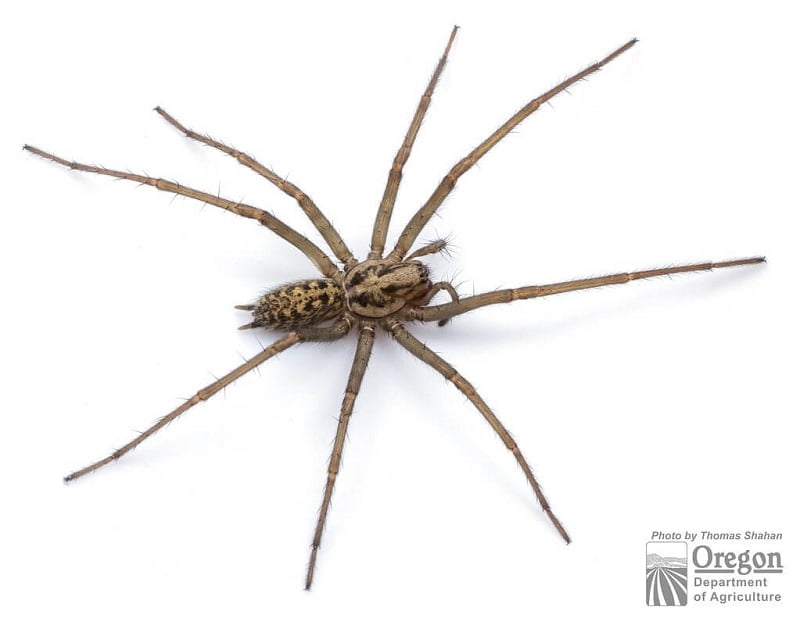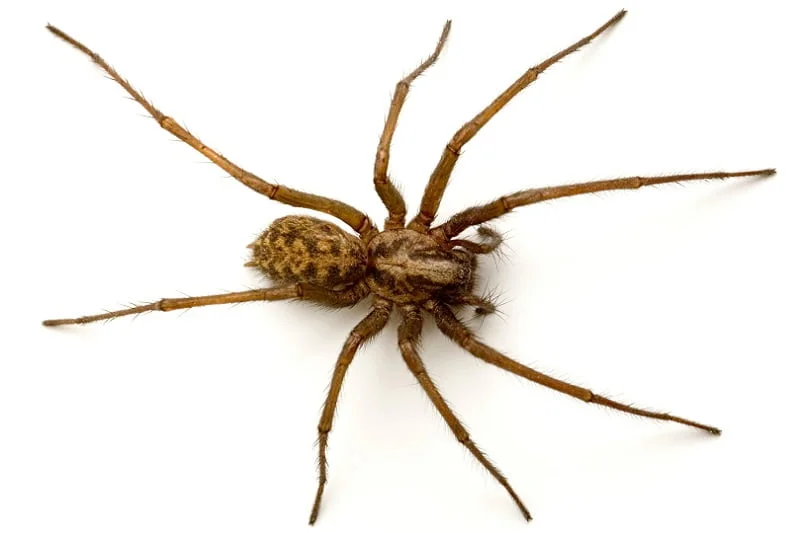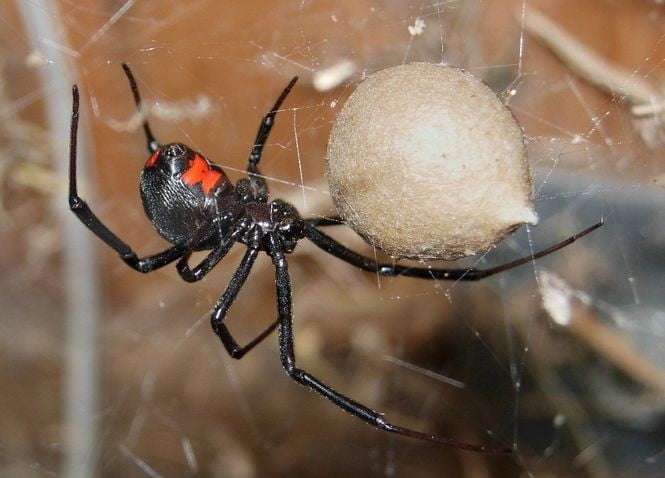Did you know that there are around 500 different species of spiders in the Pacific Northwest? The majority of them, however, are rarely encountered by humans since they thrive mostly in forest litter, rotten logs, and rock crevices far away from civilization.
The spider population in Oregon consists of both native and introduced species, meaning some have existed in the area for hundreds of years while others have been accidentally or intentionally transported by humans. This happens when spiders hitch a ride in vehicles, luggage or other transported materials, which explains why some spider species have been found outside of their known range.
What are the most common spiders in Western Oregon?
There are about a dozen or so spider species that have found their way into homes and other populated areas of Western Oregon. Luckily, only a very few of them are dangerous. Most are relatively harmless and will rather avoid humans, choosing to feed only on a wide variety of insects and other invertebrates. In fact, spider bites are very rare—it is often said that the average person isn’t likely to get bitten by a spider more than once or twice in a lifetime!
Still, spiders will bite when provoked or when they come in very close contact with humans or animals. In most instances, bites are purely accidental. You could be lighting up your fireplace and chance upon a spider sheltering in a wood pile. We’ve heard stories of people getting bitten by a spider when putting on clothing or footwear. The fact is, spiders love dark recesses and are known to inhabit old shoes, storage bins, bookshelves, linen cabinets, tool sheds, and other less disturbed areas of a home.
Some of the common spiders in Western Oregon can bite when provoked.
So which spiders should you be on the lookout for if you live in Beaverton or other areas in the US Pacific Northwest? Well, ask any Oregonian about spiders and you’ll most likely end up talking about four more prevalent spider species:
- Giant House Spider
- Hobo Spider
- Wolf Spider
- Black Widow Spider
Let’s take a look at each of these Oregon spiders in detail.
Giant House Spider (Eratigena atrica)

Giant house spiders found in Oregon are highly variable in size and appearance. They range from brown to grayish-brown in color, with a body measuring anywhere from ½ to 1 inch in length and leg spans reaching up to 4 inches for large adults. Both the body and legs of giant house spiders are somewhat hairy, with markings that are either barely visible or highly distinct.
Because of their wide variations in size, color and markings, it can be a challenge to identify giant house spiders at a glance. Smaller males, in particular, are frequently mistaken for hobo spiders. The differences between the two are very subtle and the best way to distinguish them is to use a magnifier. Better still (and if you’re brave enough), simply turn the spider on its back and observe the sternum—if it has round markings on it, then it’s a giant house spider. If it doesn’t, then you’re looking at a hobo spider.
Giant house spiders become more visible during the mid-summer to early fall. Male spiders, in particular, are highly mobile as they wander about in search of mates. Outdoors, you’ll find them in firewood stacks or in gaps between stones and bricks. Inside homes, giant house spiders usually settle in garages and basements. They’re not active climbers so you’ll mostly find them on the floor. Sometimes, you’ll also see them in sinks and bathtubs where they often venture to in search of water.
Giant house spiders are never aggressive and will usually dash off very quickly when startled. Apart from their huge size and menacing appearance, this species doesn’t pose much of a threat except for their messy webs.
Hobo Spider (Tegenaria agrestis)

The hobo spider is among the most common spider species found in homes in Beaverton and across the Pacific Northwest region. Surprisingly they’re not native to the area but were only accidentally introduced to the Northwestern United States from Europe in the 1980s. Hobo spiders are considered more aggressive than other spiders and will bite, but only when threatened or provoked.
Hobo spiders have features common with other spiders. They generally exhibit varying hues of brown and can easily be confused with wolf spiders and brown recluse spiders. Females have a body length of about 11-14 mm, with abdomens slightly larger than that of their male counterparts. Males measure no longer than 11 mm and have a swollen appendage. This can appear menacing but the truth is, it’s just their reproductive organs. The legs of both male and female hobo spiders are solid brown and exhibit no distinct markings. Perhaps the most distinguishing characteristic of hobo spiders are eight eyes clustered together. However, you will need a magnifier to see this as they’re hard to notice with the naked eye.
Hobo spiders make their way into homes during the late summer and early fall, often in search of a mate. They prefer dark and damp hiding places and will often make your basement or garage their home through the winter. Hobo spider nesting spots include crevices in bricks and dark sections between storage boxes, behind furniture and even under radiators.
Hobo spider aggression is often misinterpreted. By nature, they’re not really that vicious but are simply and extremely protective of their eggs and their young. Most hobo spider bites are a result of humans unknowingly encroaching upon a hobo spider protecting its brood. Past studies have reported that hobo spider bites can be a medical threat that will result to necrotic lesions. Further research, however, has refuted this but it still won’t hurt to seek medical attention after being bitten by a hobo spider.
Wolf Spider (Lycosidae spp.)

Wolf spiders are large and hairy ground-dwelling spiders, inhabiting mostly meadows, forests, and grasslands in the outdoors. They become a common household pest during the fall as they search for a warmer place indoors to overwinter. Unlike the giant house spider and hobo spider, wolf spiders do not spin webs or build nests. Rather, they chase and pounce on their insect prey like wolves—hence the name. They move with lightning speed, mash up and inject a venom that liquefies the internal organs of their catch to make a meal.
Wolf spiders measure anywhere from ½ – 2 inches long. They range in tones of brown and gray with various lines and markings that help them blend with their surroundings as they hunt for prey or avoid their predators alike.
The easiest way to accurately identify wolf spiders is with their eight dark eyes strategically arranged around their heads. There are a pair of large ones on top, with two more peering out the front. Four smaller eyes can also be seen forming a row just above their mouths, which leaves us with no question on why they are considered one of the best hunters in the spider world.
Despite their intimidating name and appearance, wolf spiders are actually shy creatures that choose to run away when disturbed. Just the same they’ll bite when provoked, especially when they are guarding their young which they carry on their backs until they’re old enough to hunt on their own. Bites from wolf spiders aren’t poisonous but may cause reactions in sensitive individuals.
Black Widow Spider (Latrodectus hesperus)

The name itself can cause shivers to run up your spine. There’s actually reason to because black widow spiders may be the only potentially harmful spider in the whole of Oregon. They can be found with some frequency in the north but are more common in the southwest and eastern sections of the state.
One thing to keep in mind about black widows is that it is only the adult females that come with the venomous capabilities. Adult female widows have a glossy black body measuring around 1.2 – 1.6 inches in diameter. They have slender legs and are generally larger than their male counterparts. They are also easily identified by a distinct red marking on their bellies which resembles the shape of an hourglass.
Male black widows, on the other hand, do not develop this hourglass shape. Instead, they come with white or yellow stripes and are distinctively smaller. They are also rarely seen or encountered compared to adult female black widows.
Black widows prefer dark, cool places such as garages, basements, and crawl spaces. They make messy looking webs in tight corners and crevices near the ground or behind and underneath furniture or other storage items. Once they spin a web, they rarely leave it unless disturbed.
While black widow spider bites are rarely fatal, they should be given immediate medical attention. Symptoms arising from bites include nausea, profuse perspiration, labored breathing, fever, tremors, and abdominal muscle cramps. If left untreated, these symptoms damage the nervous system and can cause death.
It is also worth mentioning that there are a few spider species found in and around Oregon homes that closely resemble a female black widow. On top of the list is the false black widow which is an exact replica, except for the absence of the red hourglass marking on the underside of the abdomen. For this reason, it is always advisable to save the specimen for proper identification in case you or someone you know has been bitten by a suspected black widow spider.
Should you get rid of Oregon spiders?
Spiders are creepy crawlies that are often misunderstood. Except for their messy webs, most spiders can actually be your allies as they do quite a bit of pest control of their own by catching other undesirable and destructive insects such as ants, flies, mosquitoes and cockroaches. Still the same, they can become nuisance pests in the home especially when present in large numbers. Here are a few tips to eliminate or reduce spider populations to keep your home clean and pest-free throughout the seasons of the year.
- Remove existing spider webs from windows, door frames, corners, and eaves
- Seal off cracks and openings to your home. You can use weather stripping, sealant or wood putty for window frame gaps and construction foam for those around plumbing.
- Replace old and torn window screens.
- Install rubber, plastic, or brush gaskets underneath doors that lead outdoors or into the garage or basement.
- Watch for spiders if you bring firewood, potted plants, or other objects in from outside.
- Vacuum regularly, paying special attention to nooks, crannies, and areas beneath furniture.
- Shake clothes, shoes, bath towels and bed linen before using.
- Place sticky spider traps in dark corners and under furniture. They provide a safe, non-toxic way to trap spiders and give you an idea of the spider population in your home.

If you’ve done all these suggestions but are still noticing an uncontrollable amount of spiders in your home, get in touch with Ant & Garden Organic Pest Control in Beaverton, OR. We can answer any questions you may have about spider pest control and removal or arrange a treatment suited to your particular situation.
You may also want to check out our other article on 10 Oregon House Pests That Bite.
